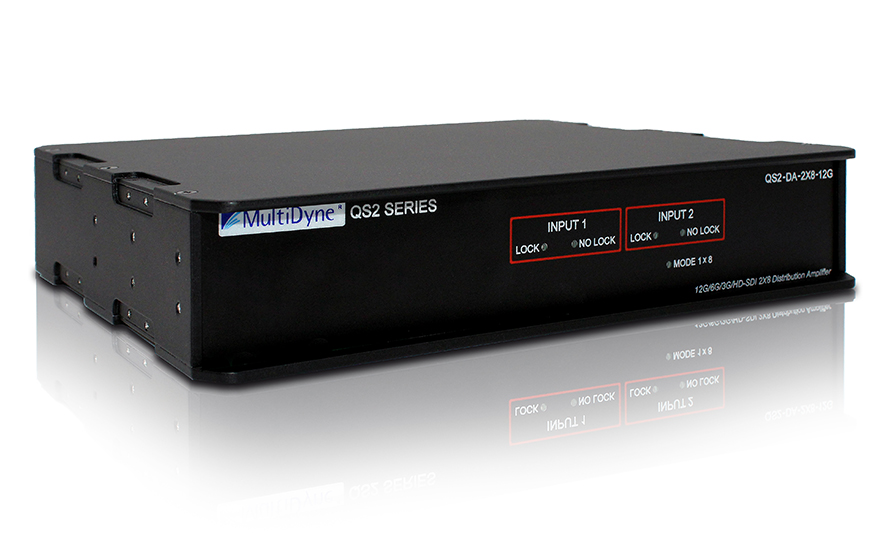
When to Choose Standalone Signal Management Over Integrated Systems
MultiDyne’s QUBE Series exemplifies the power of standalone signal management by offering a rugged, dedicated solution for 12G-SDI failover, distribution, and routing.—Mon 07, 2025—
Signal management plays a critical role in ensuring efficient, reliable workflows in broadcasting, production, and other industries that rely on high-quality signal processing. With evolving technology, organizations often have to decide between standalone signal management solutions and integrated systems. While both options have their merits, standalone signal management shines in specific scenarios, offering unique advantages tailored to specific needs. MultiDyne’s QUBE Series serves as a notable example, providing a robust and flexible solution.
Here’s how to determine when standalone signal management is the better choice.
Understanding Standalone Signal Management
Standalone signal management refers to independent systems designed specifically for managing and processing signals. Unlike integrated systems, where signal management is just one of several embedded functions, it focuses solely on this singular objective. MultiDyne’s QUBE Series exemplifies the power of standalone systems by offering a rugged, dedicated solution for 12G-SDI failover, distribution, and routing.
These systems typically come in compact form factors, making them portable and easy to deploy. Their simplicity can be deceiving, as they often provide high-end functionality without added complexities.
Benefits of Standalone Signal Management
Standalone systems provide a range of advantages that make them the ideal choice in diverse applications. Here are some key benefits:
- Reliability: Because their sole purpose is signal management, standalone systems often deliver higher reliability. There’s less risk of functionality being compromised by other systems’ failures.
- Flexibility and Customization: Standalone systems can be tailored to provide exactly the functionality you need—no more, no less.
- Simplicity: These solutions are user-friendly, often intentionally designed to be straightforward, saving time on training and setup.
- Portability: With compact, rugged enclosures like those in the QUBE Series, standalone systems are easy to move and deploy in different locations.
- Independence: They reduce reliance on complex, multi-layered systems, making troubleshooting and maintenance faster and easier.
When to Opt for Standalone Signal Management
While integrated systems are suitable for more compact, all-in-one solutions, many scenarios clearly favor standalone signal management. Here are some key situations where a standalone solution like the MultiDyne QUBE Series is the better fit:
1. Demand for High Reliability
If uptime is critical, such as with live broadcasting or a dynamic production setup, standalone systems ensure that signal management operates independently of other system functions. This level of stability reduces the chances of cascading failures.
2. Specialized Needs
For facilities that require specific functionalities like 12G-SDI routing or failover management, a dedicated system ensures these needs are met efficiently. The QUBE Series, for instance, addresses these demands with precision.
3. Rough Environments
Standalone units often feature rugged designs that are better suited for outdoor production or remote locations. Their portability, combined with durability, makes standalone systems a go-to for challenging environments.
4. Scalability
Unlike integrated systems that often come as fixed packages, standalone solutions grow with your needs. Start small, and add more systems as your requirements expand.
Why MultiDyne’s QUBE Series Stands Out
The QUBE Series takes standalone signal management to the next level. Designed specifically for rugged use, these systems can handle demanding tasks like failover and distribution while maintaining reliability. They also integrate seamlessly with other products, such as VX systems, to offer a hybrid approach when needed.
Key Features of the QUBE Series
- Rugged standalone form factor
- 12G-SDI failover and signal routing
- Compatibility with other MultiDyne products for hybrid workflows
- Portable and rackable alongside other systems
This combination of flexibility, ruggedness, and performance positions the QUBE Series as an ideal choice for professionals looking for reliable signal management solutions.
Explore Standalone Signal Management Solutions Today
When your operations demand reliability, flexibility, and a simplified workflow, standalone signal management outshines integrated systems. MultiDyne’s QUBE Series delivers precisely what you need with its rugged design and advanced capabilities.
To learn more about how the QUBE Series can transform your signal management processes, explore the lineup here. Whether for broadcasting, live production, or remote events, MultiDyne has the tools you need to get the job done.
For more information about our products, contact us today.
